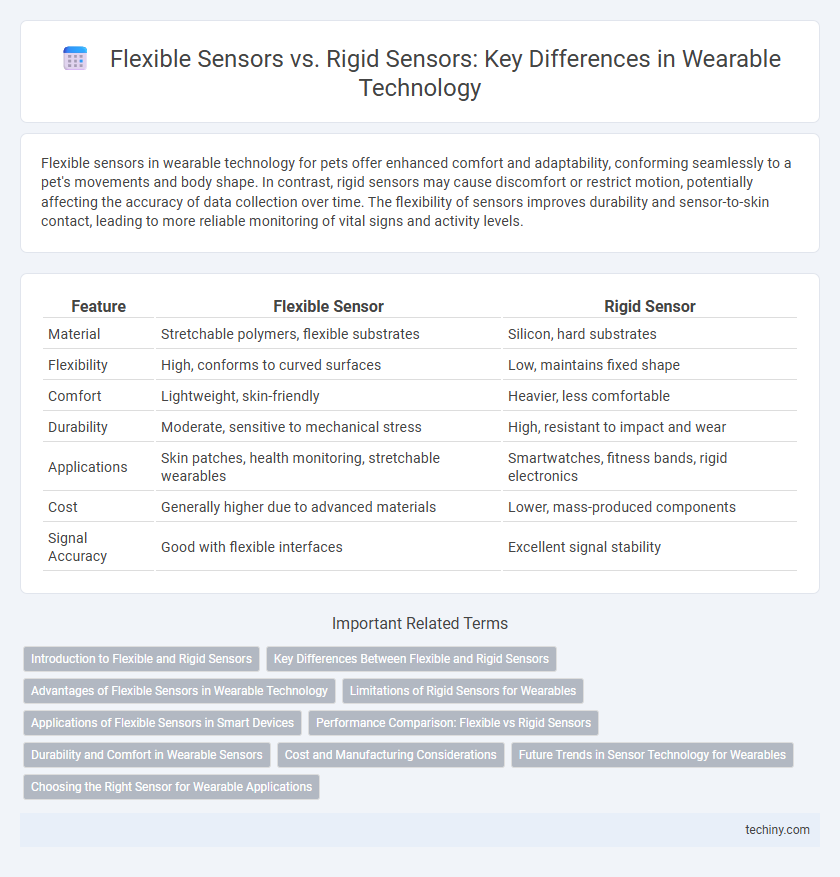Flexible sensors in wearable technology for pets offer enhanced comfort and adaptability, conforming seamlessly to a pet's movements and body shape. In contrast, rigid sensors may cause discomfort or restrict motion, potentially affecting the accuracy of data collection over time. The flexibility of sensors improves durability and sensor-to-skin contact, leading to more reliable monitoring of vital signs and activity levels.
Table of Comparison
| Feature | Flexible Sensor | Rigid Sensor |
|---|---|---|
| Material | Stretchable polymers, flexible substrates | Silicon, hard substrates |
| Flexibility | High, conforms to curved surfaces | Low, maintains fixed shape |
| Comfort | Lightweight, skin-friendly | Heavier, less comfortable |
| Durability | Moderate, sensitive to mechanical stress | High, resistant to impact and wear |
| Applications | Skin patches, health monitoring, stretchable wearables | Smartwatches, fitness bands, rigid electronics |
| Cost | Generally higher due to advanced materials | Lower, mass-produced components |
| Signal Accuracy | Good with flexible interfaces | Excellent signal stability |
Introduction to Flexible and Rigid Sensors
Flexible sensors are engineered using pliable materials such as polymers and conductive inks, enabling them to bend, stretch, and conform to various shapes, ideal for wearable technology applications where comfort and adaptability are crucial. In contrast, rigid sensors consist of solid substrates like silicon or glass that provide high sensitivity and stability but lack flexibility, limiting their use in dynamic or curved surfaces. The choice between flexible and rigid sensors depends on factors like mechanical durability, signal accuracy, and integration with wearable devices.
Key Differences Between Flexible and Rigid Sensors
Flexible sensors feature bendable substrates that conform to various surfaces, enhancing comfort and usability in wearable technology, while rigid sensors are built on solid, inflexible materials offering higher precision and durability. The flexibility in flexible sensors enables continuous monitoring of dynamic body movements, whereas rigid sensors provide stable measurements in fixed positions. Material composition, mechanical properties, and application usage fundamentally distinguish these two sensor types within wearable devices.
Advantages of Flexible Sensors in Wearable Technology
Flexible sensors in wearable technology offer superior conformity to the human body, enhancing comfort and accuracy in data collection compared to rigid sensors. Their ability to bend and stretch enables continuous monitoring during dynamic movements, making them ideal for health tracking and motion analysis. These sensors also reduce mechanical failure risks, increasing device durability and user reliability in daily wear.
Limitations of Rigid Sensors for Wearables
Rigid sensors used in wearable technology often suffer from limited flexibility and comfort, restricting their seamless integration with the human body. Their inability to conform to complex, dynamic body movements leads to decreased accuracy and potential signal loss during physical activities. Moreover, rigid sensors are prone to mechanical failure and reduced durability when subjected to constant bending and stretching inherent in wearable applications.
Applications of Flexible Sensors in Smart Devices
Flexible sensors in wearable technology enable seamless integration with curved surfaces, enhancing comfort and real-time data collection in smart devices such as fitness trackers, health monitors, and smart textiles. Their lightweight, bendable nature allows continuous monitoring of physiological signals like heart rate, muscle activity, and skin hydration, improving user experience and accuracy. Unlike rigid sensors, flexible sensors support durable, stretchable designs essential for dynamic human movement and long-term wearability.
Performance Comparison: Flexible vs Rigid Sensors
Flexible sensors exhibit superior adaptability and comfort in wearable technology compared to rigid sensors, enabling continuous monitoring on curved or moving body parts without compromising signal accuracy. Rigid sensors often provide higher sensitivity and stability in controlled environments but lack conformability, which can result in signal loss or discomfort during prolonged use. The performance trade-off between flexible and rigid sensors hinges on application-specific requirements, with flexible sensors excelling in dynamic, real-world conditions and rigid sensors favored for precision in static scenarios.
Durability and Comfort in Wearable Sensors
Flexible sensors in wearable technology offer enhanced comfort by conforming to the body's contours, reducing irritation and enabling long-term wear. In contrast, rigid sensors provide robust durability against mechanical stresses but often compromise comfort due to their stiffness. Innovations in flexible sensor materials aim to balance durability with skin-friendly properties, optimizing user experience in continuous health monitoring.
Cost and Manufacturing Considerations
Flexible sensors offer lower manufacturing costs due to the use of scalable printing techniques and inexpensive substrates like polymers, enabling mass production flexibility. Rigid sensors involve higher expenses related to complex assembly processes and costly semiconductor materials often used in traditional silicon-based designs. The choice between flexible and rigid sensors significantly impacts overall production budgets and device affordability in wearable technology applications.
Future Trends in Sensor Technology for Wearables
Flexible sensors are poised to dominate the future of wearable technology due to their ability to conform to complex body contours, providing enhanced comfort and continuous physiological monitoring with higher accuracy. Advances in materials science, such as the integration of graphene and stretchable polymers, are driving improvements in sensitivity, durability, and biocompatibility of flexible sensors over traditional rigid sensors. Emerging applications in healthcare and fitness wearables prioritize flexible sensor technology for seamless integration, real-time data acquisition, and better user experience.
Choosing the Right Sensor for Wearable Applications
Flexible sensors offer enhanced comfort and adaptability for wearable technology, conforming seamlessly to body contours and enabling accurate motion tracking. Rigid sensors provide higher durability and precision in stable environments but may cause discomfort during prolonged wear. Selecting the right sensor depends on balancing flexibility requirements, sensor accuracy, durability, and the specific use case in health monitoring or fitness tracking.
Flexible Sensor vs Rigid Sensor Infographic

 techiny.com
techiny.com